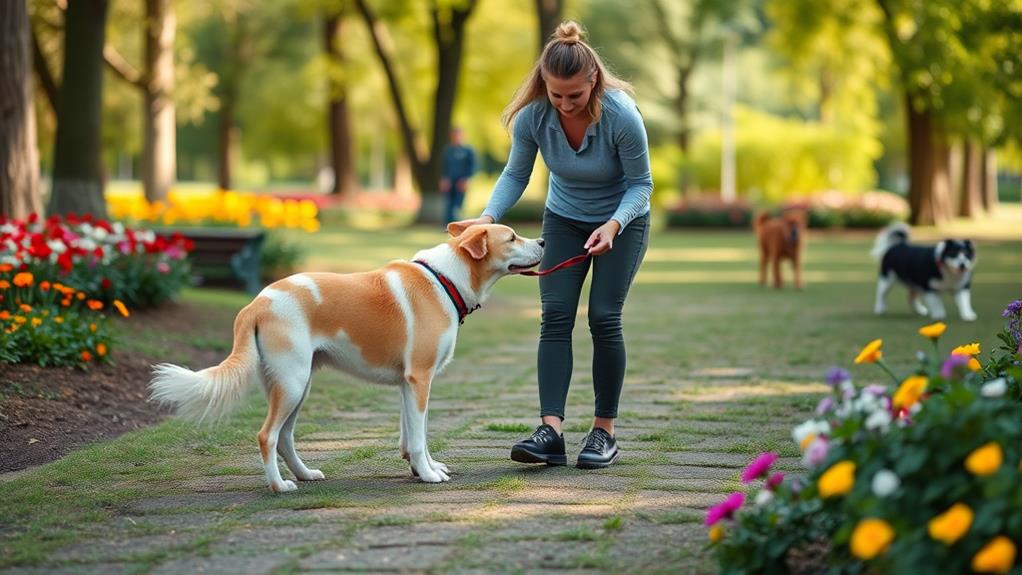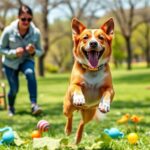Taming a reactive dog starts with understanding their triggers and creating a safe space. Use positive reinforcement to reward calm behaviors and implement desensitization techniques by gradually exposing them to triggers while monitoring their stress levels. Controlled socialization with a variety of people and environments is essential. Consider professional training for additional support, and maintain a consistent routine to help your dog feel secure. Remember, adequate exercise and mental stimulation are critical too. Stick with these tips, and you'll see progress; there's more to explore that can enhance your journey.
Understand Your Dog's Triggers

To effectively manage a reactive dog, it's crucial to understand their triggers. Triggers can vary widely from dog to dog, so you'll need to pay close attention. Common triggers include other dogs, loud noises, strangers, or specific situations like crowded spaces. When your dog reacts, take note of the environment. What was happening right before the outburst? Identifying these moments will help you recognize patterns in their behavior.
Once you've pinpointed the triggers, you can start to create a plan to manage them. For instance, if your dog reacts to other dogs, consider choosing quieter times for walks or areas less populated with other pets. Keeping a journal can be beneficial—documenting your dog's reactions will give you valuable insights over time.
Be patient with this process. It might take a while to fully understand your dog's specific triggers and how they respond to them. Remember, each dog is unique, so what works for one may not work for another. Your goal is to create a safe environment where your dog feels comfortable, reducing their reactive behavior in the long run.
Implement Positive Reinforcement

Implementing positive reinforcement is one of the most effective strategies for managing a reactive dog. This method focuses on rewarding your dog for desirable behaviors, which encourages them to repeat those actions. When your dog remains calm in the presence of triggers, immediately offer treats, praise, or playtime. This creates a positive association with the situation, helping to reduce reactivity over time.
Start by identifying moments when your dog behaves well, even if it's a small improvement. If they look at you instead of reacting, celebrate that choice! Consistency is key, so make sure to reward your dog every time they exhibit calm behavior. Gradually, you'll notice they'll be more inclined to react positively, as they'll learn that good things happen when they stay composed.
Remember to keep the rewards high-value, especially when introducing new triggers. You want your dog to feel motivated to engage in the desired behavior. Avoid punishment, as it can increase anxiety and worsen reactivity. By focusing on positive reinforcement, you'll create a trusting bond with your dog, paving the way for effective training and a happier, more relaxed companion.
Use Desensitization Techniques

Building on the foundation of positive reinforcement, desensitization techniques can further help your reactive dog feel more at ease around their triggers. This process involves gradually exposing your dog to the things that cause them stress, while ensuring the exposure remains at a manageable level. Start by identifying your dog's specific triggers, whether it's other dogs, loud noises, or unfamiliar people.
Once you've pinpointed these triggers, create a controlled environment where you can introduce them in a less intense manner. For example, if your dog reacts to other dogs, consider starting with a distant sighting of a calm dog. Keep a safe distance where your dog can see the trigger but doesn't feel overwhelmed. Reward your dog with treats and praise for remaining calm during this exposure.
As your dog becomes more comfortable, slowly decrease the distance to the trigger, continuing to use positive reinforcement. Remember, patience is key. Don't rush the process; instead, progress at a pace that suits your dog. Over time, you'll help your pup build resilience and reduce their reactivity, creating a more relaxed and enjoyable experience for both of you.
Establish a Safe Space

Creating a sense of security is essential for helping your reactive dog thrive. Establishing a safe space in your home allows your dog to retreat and feel secure when they're overwhelmed.
Start by choosing a quiet area, free from distractions and sudden noises. This could be a specific room, a cozy corner, or even a crate if your dog finds it comforting.
Make this space inviting. Use your dog's favorite blankets, toys, and perhaps an item of your clothing to provide familiar scents. You want your dog to associate this area with safety and comfort, so avoid using it for punishment or time-outs.
When your dog shows signs of stress, gently guide them to this safe space, encouraging them to relax. You can also spend time there with them, reinforcing the positive feelings associated with this area.
Practice Controlled Socialization

Once your dog feels secure in their safe space, you can begin to practice controlled socialization. Start by introducing your dog to other dogs or people in a controlled environment. Choose a quiet park or a friend's yard where you can manage the situation effectively. Keep your dog on a leash and maintain a safe distance from the other dog or person, allowing them to observe without feeling overwhelmed.
Gradually decrease the distance as your dog becomes more comfortable. Use treats and praise to reinforce positive behavior. If your dog shows signs of stress, like barking or lunging, increase the distance again and give them time to calm down. Remember, patience is key; rushing this process can backfire.
Incorporate short, positive interactions with well-mannered dogs or calm people. Monitor your dog's body language closely to guarantee they're relaxed and engaged. If necessary, take breaks to avoid overstimulation. Controlled socialization teaches your dog how to interact appropriately, which helps build their confidence and reduces reactivity over time. Consistent practice in a safe, controlled environment sets the foundation for better social skills in various situations.
Leverage Professional Training

When dealing with reactive dogs, seeking professional training can be a game changer for both you and your pet. A skilled trainer can assess your dog's specific triggers and behaviors, helping you understand the best techniques to address these issues. They can teach you effective communication methods, ensuring you and your dog are on the same page.
In a controlled environment, trainers often use positive reinforcement techniques that encourage desirable behaviors while discouraging reactivity. This approach not only builds trust between you and your dog but also fosters a deeper bond. You'll learn how to manage your dog's reactions in real-life situations, which can vastly reduce stress for both of you.
Additionally, professional trainers can provide valuable insights into your dog's body language, helping you recognize signs of anxiety or aggression before they escalate. Attending group classes can also offer socialization opportunities for your dog, allowing them to interact with other dogs in a safe setting.
Ultimately, leveraging professional training equips you with the skills and knowledge necessary to help your reactive dog thrive. Investing in training can lead to a more enjoyable and fulfilling life together, transforming challenges into opportunities for growth.
Maintain Consistent Routine

A consistent routine is essential for helping reactive dogs feel secure and balanced. When you establish a regular schedule for feeding, walking, and training, your dog knows what to expect, which can greatly reduce anxiety.
Start by setting specific times for meals and walks. This predictability allows your dog to relax, as they won't be on edge wondering when the next activity will occur.
In addition to meal and walk schedules, incorporate consistent training sessions into your routine. Short, daily training exercises reinforce desired behaviors and help your dog learn to cope with triggers in a controlled environment.
Stick to the same commands and cues to avoid confusion, making it easier for your dog to understand what's expected.
Frequently Asked Questions
How Long Does It Take to See Improvement in My Dog?
You'll likely notice some improvement in your dog within a few weeks, but significant changes can take several months. Consistency, patience, and positive reinforcement are key to helping your furry friend progress effectively.
Can Medication Help With My Dog's Reactivity?
Medication can definitely help with your dog's reactivity. It often works alongside training to reduce anxiety and improve focus, making it easier for your pup to learn new behaviors and cope with stressful situations.
What Should I Do During an Unexpected Outburst?
When chaos erupts like a sudden storm, stay calm. Use a soothing voice, redirect your dog's attention, and create distance from triggers. Your composed energy can guide them back to a peaceful state.
Are Certain Breeds More Reactive Than Others?
Yes, certain breeds are often more reactive due to their instincts and temperaments. Breeds like Border Collies and Jack Russell Terriers can be particularly sensitive, so understanding their behavior's pivotal for effective training and management.
How Can I Help My Dog at Home Between Training Sessions?
Think of your dog as a sponge, soaking up experiences. Between training sessions, you can reinforce positive behaviors through structured play, consistent routines, and engaging activities that keep their minds sharp and spirits high.
Conclusion
By understanding your dog's triggers and using positive reinforcement, you're not just training; you're building a bond akin to the loyalty of Odysseus and his faithful companions. As you establish a safe space and practice socialization, remember that patience is key. Embrace professional training when needed, and maintain a consistent routine to guide your dog's journey. With these proven tips, you'll transform your reactive dog's behavior, allowing them to thrive in a world that once felt overwhelming.



